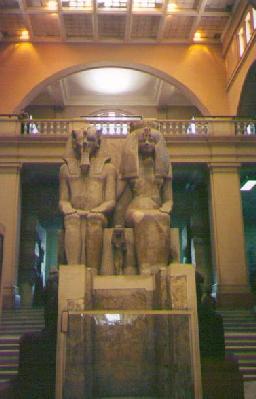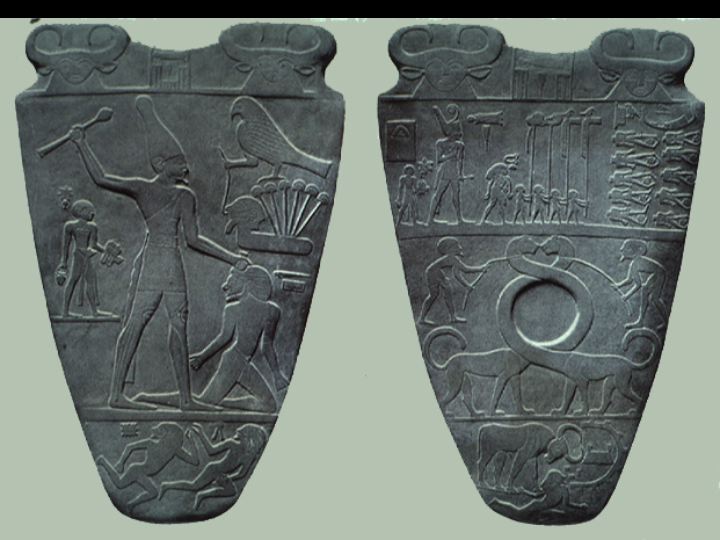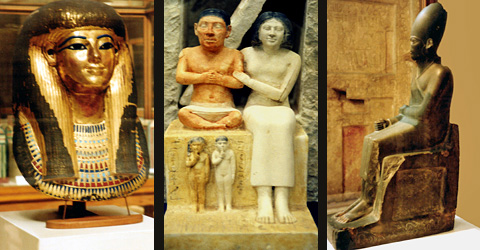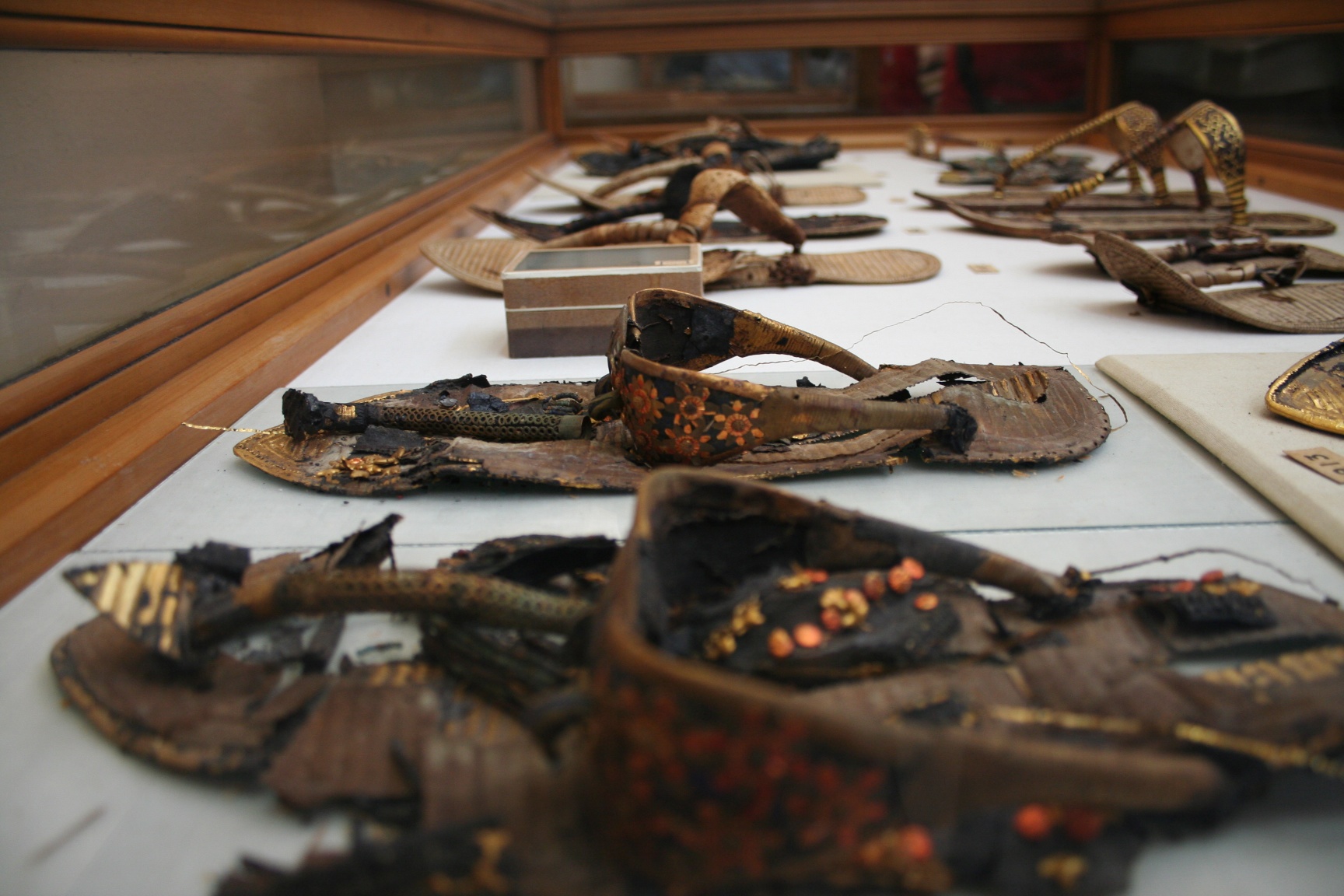We cross many lanes of fast traffic on several occasions – routine for a Cairene, harrowing for us. At the high court near our hotel and on the way to the museum, we see several formations of more than 100 black clad helmeted riot police which shields, body armor and long batons.
We had intended to remain at the museum until it closes at 6 p.m. It is very hard to know where to start, but Dalia, of course, has a plan. She also tells us she will stay in touch with Samir about what’s happening on the street.
We feel a real thrill as we pass through the gates onto the grounds of this world-famous museum. We know this can only be the cursory visit - the museum houses more than 120,000 artifacts, going back to pre-dynastic times.
Our first stop is on the grounds of the museum where there are some beautiful large pieces on display.
Once we enter the museum, cameras are not allowed. (The pictures below came from various places on the Internet.)
Dalia tells us it seems to her that the museum is uncharacteristically uncrowded, and speculates that many people have called off their visit. Our visit turned out to be the last day the Museum was open, as the revolution took off. Dalia tells us, very regretfully, that most visitors to the museum are foreigners, implying that Egyptians do not fully appreciate their ancient heritage.
We start on the ground floor.
The main hall of the museum as you enter is breathtaking. You will see "in the flesh" ancient statues you have seen in books all your life. There is some frustration for visitors because labeling is rather haphazard. There is a very good guidebook to the museum (which can be purchased on line) but even that is far from perfect. Dalia says Egypt plans to build a new Egyptian Museum on the Giza Plateau for this wonderful collection. It will be air conditioned, which the current museum is not. That should extend the tourist season into the hotter parts of the year, and may help preserve the artifacts as well. Probably improvements will also include better labeling, but this minor frustration takes little away from the stunning collections. Dalia, of course,helps us to understand what we are seeing.
For the most part, the exhibits are organized chronologically, though in some cases the size of objects dictates their location.
We feel a real thrill as we pass through the gates onto the grounds of this world-famous museum. We know this can only be the cursory visit - the museum houses more than 120,000 artifacts, going back to pre-dynastic times.
 |
| Main gate of the museum |
 |
| Sphinx of Tutmoses III found at Karnak in the dedicated to Amun-Ra |
 |
| Fragment of obelisk of Rameses II found at Tanis |
 |
| A statue that seems to embody the concept that behind every great man, there is a great woman |
 |
| Auguste Mariette,founder of the museum, is buried in the nearby mausoleum on the museum grounds |
 |
| This butterfly, on the grounds of the Egyptian Museum, is the only one we see well enough to identify in our two weeks in Egypt (Catopsila florella) |
Once we enter the museum, cameras are not allowed. (The pictures below came from various places on the Internet.)
Dalia tells us it seems to her that the museum is uncharacteristically uncrowded, and speculates that many people have called off their visit. Our visit turned out to be the last day the Museum was open, as the revolution took off. Dalia tells us, very regretfully, that most visitors to the museum are foreigners, implying that Egyptians do not fully appreciate their ancient heritage.
We start on the ground floor.

The main hall of the museum as you enter is breathtaking. You will see "in the flesh" ancient statues you have seen in books all your life. There is some frustration for visitors because labeling is rather haphazard. There is a very good guidebook to the museum (which can be purchased on line) but even that is far from perfect. Dalia says Egypt plans to build a new Egyptian Museum on the Giza Plateau for this wonderful collection. It will be air conditioned, which the current museum is not. That should extend the tourist season into the hotter parts of the year, and may help preserve the artifacts as well. Probably improvements will also include better labeling, but this minor frustration takes little away from the stunning collections. Dalia, of course,helps us to understand what we are seeing.
For the most part, the exhibits are organized chronologically, though in some cases the size of objects dictates their location.
 |
| Amenhotep III and Queen Tiy (18th Dynasty) was originally located at Thebes, but Amenhotep's temple was destroyed to make room for a later one, leaving only the so-called colossi of Memnon to mark its location. This colossal group was found in pieces at Habu by Mariette, and brought and re-assembled. |
Also 18th Dynasty is a statue of Tutmoses III - he became king when his father, Tutmoses II died, but because he was just a child, his stepmother became regent. She was the great Hatshepsut who entered up ruling Egypt as king for 20 years, long after Tutmoses III was an adult. In some places he is portraryed as "co-pharoah." with her.
 |
| Tutmoses III |
Some of the painted images are especially striking. This couple, perhaps members of the royal family, was found in a mastaba near the Meidum pyramid. Their eyes are still amazingly lifelike, especially when you consider they are more than 4,500 years old, 2575 to 2467 BC.
 |
| Early 4th Dynasty, Rahotep and Norfet, painted limestone, inlaid eyes |
We think the palette of Narmer may be of the most striking items we see in the museum.

This palette is thought to commemorate the victories of King Narmer, who came from the south of Egypt to invade the Delta in about 3000 B.C.
Thiis is how it appears in the museum |
The interpretation of this palette has evolved since it was discovered about 100 years ago. It is said to represent the most important evidence that the first political unification in the history of mankind occurred in Egypt
The Serekh is flanked by two female heads having the ears and horns of a cow, which could be the first representation of the goddess Hathor.
The scene on the front shows the king, followed by his sandals bearer and wearing the White Crown of Upper Egypt, smiting a helpless foe from the North.
The upper section of the back side shows the king wearing the Red Crown of Lower Egypt, followed by his sandals bearer and preceded by his vizier and four standard bearers. In the middle section, there are two men holding two felines with extremely long necks representing the people of the North and South under the control of the king and his men.
The Serekh is flanked by two female heads having the ears and horns of a cow, which could be the first representation of the goddess Hathor.
The scene on the front shows the king, followed by his sandals bearer and wearing the White Crown of Upper Egypt, smiting a helpless foe from the North.
The upper section of the back side shows the king wearing the Red Crown of Lower Egypt, followed by his sandals bearer and preceded by his vizier and four standard bearers. In the middle section, there are two men holding two felines with extremely long necks representing the people of the North and South under the control of the king and his men.
 |
| This is the Pharaoh Khafre, builder of the second pyramid at Giza |
This often used device also has a practical purpose, as it serves to strengthen the neck of the statue. Twenty-three identical copies of this statue were found in his mortuary temple. It dates to 2500 BC, and the artist was able to carve this masterpiece from very hard diorite with no metal tools.
 |
| Left: Yuya, gilded mask 18th Dynasty; Center; Old Kingdom couple, Seneb is a dwarf; Right, statue of Khasekhem, 2nd Dynasty |

 |
| This floor survived in spite of the palace of mud brick being in complete ruins, as we have seen in Amarna |
We have seen a great deal but still realize we have barely touched of surface of what there is to see. Still we hear the protests may begin again today and decide to head upstairs to see the incomparable King Tut collection.
Tut died unexpectedly at the age of 18 or 19. because the body must be mummified, placed in the tomb and the tomb sealed 70 days after death, there was little time to assemble the sorts of treasures that would ordinarily have accompanied a pharaoh to the next world. But included in the tomb are many objects that Tut probably used in his daily life. For example, there is a case containing sandals, ranging in size from those he wore as a small child to ones he would have worn at the time of his death.

Dalia says she is very surprised at the Gold Room - usually she tells us there is a line to enter, but today, there are a few people in there (probably because of the protests) and we are able to look at the exhibits at our leisure. We stand and stare into the eyes of this, his death mask, as lifelike as can be imagined.

As beautiful of this iconic death mask is, some of the jewelry here is stunning beyond belief.
Tut died unexpectedly at the age of 18 or 19. because the body must be mummified, placed in the tomb and the tomb sealed 70 days after death, there was little time to assemble the sorts of treasures that would ordinarily have accompanied a pharaoh to the next world. But included in the tomb are many objects that Tut probably used in his daily life. For example, there is a case containing sandals, ranging in size from those he wore as a small child to ones he would have worn at the time of his death.

Dalia says she is very surprised at the Gold Room - usually she tells us there is a line to enter, but today, there are a few people in there (probably because of the protests) and we are able to look at the exhibits at our leisure. We stand and stare into the eyes of this, his death mask, as lifelike as can be imagined.

As beautiful of this iconic death mask is, some of the jewelry here is stunning beyond belief.
The solid golden coffin of Tutankamun is amazing not so much for its weight (300 pounds!), as for the fineness of the workmanship.

What is difficult to imagine is the richness of this tomb of a minor king to reigned briefly and died unexpectedly. Everything had to be completed and the tomb closed 70 days after the boy-king’s death. Just think of the treasures that must have filled the tomb of a pharaoh like Rameses the Great who reigned for more than 60 years!
There are some poignant things here too: sandals Tut wore as a little boy, toys he played with and a throne with endearing images of Tut and his sister/wife Ankhesanamun. The throne depicts a pair of young people who were very fond of one another. The throne, incidentally, has his original name, Tutankhaten. He was the son of the heretic king, Akhenaten, but abandoned Amarna, his father’s city in the Western Desert

The young pharaoh was reputably very fond of charioting and experts now believe that fondness led directly to his death. He suffered a broken leg and may have died of complications from that injury. Preserved in his tomb are a number of images related to chariots, including several of his chariots.

Continuing study of Tut's mummy has found other injuries and medical issues - possible injuries suffered in warfare, and what may be a congenital foot condition that may explain the considerable collection of staffs and walking sticks found in the tomb - some well used.
The power of some pieces, statues and sphinxes of pharaohs, have so much power and are so fine. We call off seeing the royal mummies of Seti, Rameses and others in favor of clearing out before an announced 4 pm demonstration across the street. The last thing we saw was collection of animal mummies, including a crocodile that must have been 20 feet long.
When we leave, we take a roundabout route through back streets to AbouTarek, a very popular restaurant for Koshary. This is a one-dish meal made with rice, noodles, lentils, spicy tomato sauce, and chickpeas with a garlic vinegar dressing and a crispy fried onions topping. The restaurant is full of ordinary Egyptians enjoying this meal. We find it positively delicious. There is a creamy rice pudding for dessert. When we leave we change course when we encounter a phalanx of riot police on what would have been our direct route back to the hotel. We go down a narrow street filled with impromptu mechanics working on cars on the street and sidewalk - another of these informal businesses we see everywhere inEgypt
When we leave, we take a roundabout route through back streets to AbouTarek, a very popular restaurant for Koshary. This is a one-dish meal made with rice, noodles, lentils, spicy tomato sauce, and chickpeas with a garlic vinegar dressing and a crispy fried onions topping. The restaurant is full of ordinary Egyptians enjoying this meal. We find it positively delicious. There is a creamy rice pudding for dessert. When we leave we change course when we encounter a phalanx of riot police on what would have been our direct route back to the hotel. We go down a narrow street filled with impromptu mechanics working on cars on the street and sidewalk - another of these informal businesses we see everywhere in
On the way to the hotel we pass one of the ubiquitous police wagons and there is a young girl crying. Dalia speaks to her and she says her brother and sister are inside the wagon and she doesn’t know why. When we get to the hotel, we find that all of the shops on the street are locked down with metal shutters (which we have never seen before). So we do without extra water or snacks for the evening. We promise to stay in tonight, as Dalia asks.
Today theCairo Cairo Alexandria Cairo
Because no one in the hotel could go out, the hotel made tea and offered us anything else we might want . Fortunately we are still full from our dinner and not at all hungry.
Today the
 |
| Before nightfall, we don't see a lot of activity, although there is a paddy wagon, and a substantial police presence. |
As darkness falls, there wereare more and much louder demonstrations, many more people, many more concussions – tear gas we think – hoping it’s nothing worse. Things do not quiet down until well after 11 pm. Again, we are packed and ready to go at a moment notice, should that become necessary. There are unanticipated advantages to traveling light.



No comments:
Post a Comment